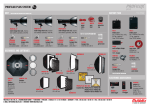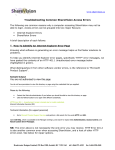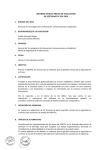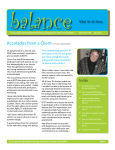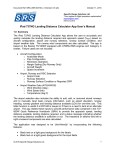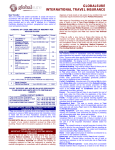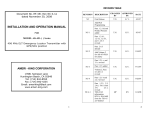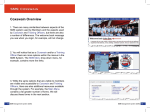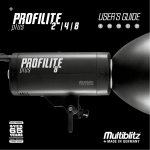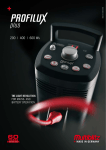Download PEP Air
Transcript
PEPA - CASARA February 2014 Happy New Year everyone. I trust the Holiday Season was good to you all. It has been a cold winter in some parts of the province, so consequently the training has also fallen off due to the bad weather. It won't be long before the temperatures start to rise and we see some clearer skies for doing flying training. Last fall we took a leap into the 21st Century with the purchase of iPads and a software program called ForeFlight. These units are a wonderful aid but a note to all who have them, they are for reference only, the navigator must still have his pen on the map in the cockpit and have all the necessary maps and paperwork. Alton King These units, although capable, are not replacing what we have Director General done and will continue to do in the cockpit. At the same time we PEP Air - CASARA purchased GoPro Hero 3 Black Edition cameras, one for each zone. These units are very small and come with a variety of attachments that can be used in a classroom or in the cockpit to record. They can be used as an aid for training. Go to http://youtu.be/k11Xh0YAX5o if you want to see a great video on an actual ELT Search. This was filmed using the GoPro. It gives you an idea of what can be Continued on next page. Al King continued. done with the units to help train other members of your group who were not on the actual SAR. I had a question from one group that asked if they had to use the unit even though one member asked not to be filmed. The member's rights always come first. If a crew for one reason or another does not want the camera put into the cockpit of the aircraft then move it to a different aircraft, or simply turn it off. The cartoonist, Ingrid Rice, was kind enough to allow the use of her cartoon without royalty. We see some changes coming down the pipe for a major SAR in the future. All major searches in the future will be run from JRCC. There will still be a satellite SHQ setup but the Search Master will be out of Victoria. Later this month 442 Squadron will be doing a SAREX using the new system to see how it all comes together. One of the major differences for us will possibly mean that we will have an SCO in the Command Post (CP) as well as at the satellite SHQ. Another major change in the near future will be no more specific military spotter training flights. All flights will be a combination flight to train the crew onboard the aircraft and incorporate spotter training when they can. Something else is that 442 will be asking members of PEP Air to come to Comox for a weekend or a couple of days during the week to bunk, eat and train with a duty SAR team. We will be working out the logistics of this over the next while, so don't expect that you are on your way to Comox right away! 442 will be travelling around the province over the next couple of months giving lectures. Here are some of the dates and places they will be stopping: March 1 - Victoria Flying Club March 19 - Nelson Flying Club March 29 - Abbotsford Flying Club Penticton and Williams Lake may also be added to this list. Don't forget that it is at this time of year when every member must do the CASARA registration form prior to March 31st, be sure to get in touch with your AAD to get the forms filled in. While on this note, each and every one of you should be signing into the CMS program to update your personal file and checking to make sure it is all correct. www.embc-air.org www.embc-air.org www.embc-air.org 2 Cranbrook Embraces iPad & ForeFlight Rick Smeland in Cranbrook using ForeFlight on his iPad. Cranbrook held its first iPad and ForeFlight training course in January. The course focused on the use of ForeFlight especially for the creation of expanding square and sector searches which are two of the most demanding patterns to plot and fly. In regards to the expanding square pattern the DND National SAR Manual states that, "It is a pattern which requires precise navigation to avoid gaps in coverage." With respect to the sector search the SAR Manual notes that, "This pattern is used when datum is established with a high degree of confidence, the search area is not extensive and the search object is difficult to detect," which would include searches in support of GSAR when PLB or SPOT beacons are activated. Searches in this category will likely increase as PLB and SPOT prices drop and more units are purchased. The ForeFlightNavLog and moving map functions make flying the expanding square and sector searches very easy. Even easier still is adjusting each of these patterns for a second search by modifying one criterion, the Initial DTK by 30° (sector search) or 45° (expanding square). Although ForeFlight does not offer a CLA search option, Cranbrook is creating CLA patterns using ForeFlight combined with a Great Circle Calculator (accessed over Safari on the iPad) available on an aviation web site at http://williams.best.vwh.net/gccalc.htm. Cranbrook is using the VNCs that come with ForeFlight and also JOGs and NRCan 1:50000 topo maps which have been downloaded. The larger scale topos are particularly useful when working with GSAR. Although we have learned much to date, it is only a small fraction of what ForeFlight has to offer. Allister Pedersen Cranbrook PEP Air Training Officer 3 The PEP Air - CASARA North East Zone set up the CASARA tent at the Quesnel Skyfest 2013 Air Show on August 3-4. We were surprised to learn from the visitors to our display how little is known about PEP Air - CASARA. The display was well received and prompted many questions from attendees at the air show. In addition to providing some much needed publicity we were privileged to witness a first class air show that included our beloved Snowbirds. The following weekend we set up in Vanderhoof for the air show and once again we were given a great welcome and had many curious visitors to the display. - Don Cadman Quesnel SkyFest 2013 4 "Don't Leave Home Without It". Allister Pedersen Cranbrook PEP Air Training Officer It was -21C on February 1st when we left home for the Canadian Rockies Airport near Cranbrook. Pilot Rick Smeland and I, along with spotter Brett Bryan were on our way to Creston for a SAREX. We flew the MVFR route and picked up the ELT signal put out by Search Coordinator Robert McLean. We completed an aural null and landed in Creston. During my second flight of the day as nav for Richard Vere, we received an all stations call from CASARA base asking each crew to check their SPOT units to ensure they were set in tracking mode. A busy workload, paperwork, and worsening Cranbrook weather meant I did not have an opportunity to discuss this call with SHQ personnel but it did raise some obvious questions and discussion on our return to CYXC. Why were the SPOT tracking positions not received? Were the units not in tracking mode? Did the nav or pilot send any "OK" or "Custom" messages before leaving home as an end-to-end test of not only the SPOT tracker but the entire network including a text to the nav or pilot's cell phone? Cranbrook PEP Air recently implemented an SOP calling for this kind of end-to-end test before any flight. Not only does an OK test message provide the end-to-end test but also forces our pilots and navs to use it more and gain more confidence in SPOT. In Cranbrook, SPOT is included in our pre-flight safety briefings so that our spotters will also know what to do in the event of an emergency landing. We still hear disparaging remarks that "ELTs activate inadvertently or do not activate when they should." ELTs of course are not perfect but this is one more reason why we should be using SPOT, especially in tracking mode. We all recognize there are emergency circumstances when neither an ELT nor SPOT will be function. However in tracking mode we are left with a ten minute window of the last known position of an aircraft. While I looked out at several jagged 9,000 foot plus peaks in Gray Creek Pass, Rick Smeland noted that "a high percentage of emergency landings are survivable, however, survivors frequently succumb to the elements because searchers are unaware of their location." At that point I looked at SPOT with a measure of comfort knowing it was sending out our location over that beautiful but unforgiving terrain below. Given the nature of our work, the terrain and our frequently changing weather, PEP Air crews should recognize more than any other organization that $@#% happens! There would be no need for us if there were no aviation or groundrelated incidents. SPOT on! 5 The Good Old Days as seen by C. Pachal Part 2 (of 7) On a Saturday in the mid-Seventies the local radio station reported that two ladies from Kelowna had gone missing from a lodge located in the high Cathedral Mountains just south of Keremeos. PEP Air had not been notified as the search was under RCMP jurisdiction as this was a ground tasking. At approximately 1400 hours the husband of one of the ladies contacted me enquiring if we could assist in the search for his wife. We called PEP in Victoria requesting a task number but as stated above, this was an RCMP search and no task number was approved. A call to the RCMP resulted in the same response. Time was of the essence as this was taking place when the weather at night became freezing cold and these ladies had been missing since Friday evening. We decided that we would on our own, without any authority to take part in the search, launch a crew and do what we could do. The Cathedral Mountains have a high elevation but there was no problem reaching that elevation departing from Kelowna. On our way Charles Pachal joined the RCAF in 1942 and retired from the Canadian we discovered that the ground search headquarters Armed Forces in 1970. He served as was located not far from Keremeos close to the CASARA National President for six highway. There was no way that anyone leaving the lodge could ever climb over the mountainous terrain years and has been a member of PEP Air for over forty-three years. to get anywhere near where they were searching. We flew over the lodge and within minutes we found the ladies well off the trail they were supposed to have used. The crew I had was Roy Clemens as the navigator and two experienced spotters, one was a government mapping expert. We circled the area to assure the ladies that we found them and then climbed to altitude to make contact with Penticton radio. Giving the accurate map location, the lodge immediately sent out their people and the ladies were successfully escorted back to the lodge. One must remember that the period I am reporting on is approximately some forty years ago, consequently some dates may be inaccurate. PEP Air was involved in many searches during the early Seventies and Eighties, both RCC and provincial. As the years went by RCC and 442 Squadron became more aware of the resource available to them as provided by PEP Air. I will At a reception some time later we discovered that the report on just a few searches, some ladies would not have survived another night in that freezing temperature. of which actually saved lives. Continued on next page. 6 http://aviationnewsjournal.com/ The Aviation News Journal is published in Vancouver and is in its 22nd year. Estimated readership has increased to over 35,000. It is the only free aviation magazine, mailed out and distributed to airports, fixed base operators, repair facilities, air carriers, flight training schools, clubs, aircraft brokers, industry suppliers, pilot supply stores and charter operators, including restaurants and coffee shops! The Good Old Days. From the previous page. Total time on this search was as follows: Departed Kelowna at 3:15 pm. Arrived at the search area at 3:42pm. Located missing subjects at 3:50 pm. Returned to base at 4:30 pm. Another interesting search took place in the mountains just north east of Kelowna one Sunday morning when we were tasked by PEP to find several skidooers who had not been heard from since Saturday morning. A crew of three managed to depart Kelowna airport shortly before 1100 hours. The temperature was below freezing with some light snow showers. This was a lucky day for us as we were flying to what was supposed to be where these people should have been. when we spotted them, six skidoos and seven people, all of them in a large clearing heading east. This was in the wrong direction as the lodge they were trying to get to was west of them. After several attempts by flying low and waving to them they finally turned around and headed west. We returned to Kelowna airport, had lunch and decided for some reason or other we had better go back and see if these people made it back to the lodge (No radio communications available). What we found was that they were again heading east away from the lodge. After finally turning them around again they did reach the lodge safely. What happened in this case was that one of their machines was stuck in a gully in deep snow and they couldn't retrieve it, that was why there were six skidoos but seven people. As was mentioned in part one, there were no standard operating procedures (SOP) in the early Seventies, therefore one priority of PEP Air was to produce a useable SOP. Information was gathered from quite a few members, I cannot remember all of their names. One member from Kamloops produced the formulae for aircraft reimbursement which is still being used today, with modifications of course, then there was Bob Goerzen from Nanaimo, Bob Goldie from Comox, myself and someone from the Island, probably some more whom I cannot recall, and of course input from 442 Squadron. We made changes just about after every exercise until what we thought was a reasonable SOP. More about this in another segment of “The Good Old Days.” 7 Photo Showcase Do you have a photo you’d like to show? Send it along! Above: Upper Fraser Valley, east of Chilliwack. Right: Mount Cheam. Below: Just north east of ZBB. 8 SARscene 2013 The SARscene Games is a one-day event that is intended to demonstrate search and rescue techniques and skills in a friendly and competitive environment. The focus is on ground and inland water searches but knowledge and techniques practiced by air and maritime SAR professionals are also be incorporated. This event is held every year and is organized jointly by the National Search and Rescue Secretariat and its co-host. Last year, the event was co-hosted by the British Columbia Search and Rescue Association (BCSARA). The Games typically bring together participants from across Canada and often internationally. The judges selected to design and evaluate the Games represent a diverse crosssection of the search and rescue community: search and rescue volunteers, police, military SAR techs, park wardens, paramedics, firefighters, Coast Guard personnel, government and industry SAR specialists. Hovercraft, UAVs and much more... Continued on next page. 9 Theresa Bernhardt, Jeff Sohy and Louise Hooymans of Team CASARA on the course... ...and the fourth member of our team, Paul Monchamp. The one day event consists of a series of six SAR related challenges that demand cooperation, knowledge and quick thinking by teams of four people. Qualified adjudicators do the scoring and the winning teams are determined on the basis of their total score for the day. The teams rotate through the six events which are located in different areas across the Games site. Both SARscene attendees and members of the general public are invited to walk through the site and view the teams as they progress through each task. The Games are coordinated from a central command post which serves as the focal point for the day's activities, including the opening ceremony, team briefing, and public information. Events in the SARscene Games are designed so that anyone with a basic level of SAR training can participate. None of the events demand specialized skills or equipment, such as high-angle rescue, confined space entry or swift water rescue. However, those participants with more experience and advanced levels of training usually earn higher scores, as well as bonus points. While the SAR skills involved are most common to the ground and inland water SAR environment, teams specializing in air and marine SAR have also competed in the SARscene Games and placed in the top three. Teams are not told in advance exactly what to expect but are advised that the following core skills may be featured in some or all of the six events: Continued on next page. 10 land navigation, including compass and/or GPS interpretation of topographic maps and common symbols common SAR knots and basic rope techniques line-heaving (rope throwing) accuracy basic low angle rescue and litter-carrying techniques visual search techniques and efficiency First Aid and emergency scene management survival skills: the construction of ground-to-air signals, fire, improvised shelters search management theory and application of SAR knowledge (coordinate systems, terminology, search techniques, phonetic alphabet) judgement, ingenuity, teamwork Time is also allotted during each rotation for the judges to give some general feedback on each team's performance. In addition to friendly competition, the Games are also intended to promote exchange between SAR workers from across Canada and beyond. Teams are made up of four people of any age (18 years and up) and background. Some may be provincial finalists representing their SAR volunteer association; some may be paid professionals that work together in an operational unit or squadron; others may be friends or SAR colleagues who are attending SARscene. All teams enter the Games in a spirit of friendly competition. If time and space permit, it may be possible to form an impromptu team on the day of the event but advance registration is recommended. About 350 search and rescue personnel attended at the RCMP's Pacific Region Training Centre (PRTC) for SARScene. The last time it was held in BC was in 2007, in Victoria. 11 So I purchased an iPad! The idea being that I would acquire the latest digital charts just released by NavCanada and move away from those large flappy pieces of paper that always seemed to need replacing or don't quite cover all of the area I am planning to fly to (or might want to fly to – some days I am not clear on the difference!). I did quite a bit of research before my purchase and was astonished at what the various applications (apps) would allow me to do. I decided on an app and purchased a one year subscription. Don McDonald Provincial PEP Air Safety Officer Almost immediately, I had on my iPad a complete set of Canadian VNCs and VTAs that looked exactly like the paper ones (when they were new and crisply sharp!). They are geo-referenced so that they interact with a GPS and give a moving map display which can be zoomed in or out. Included with the subscription are all of the IFR charts, plates and CFS information. Current composite radar, satellite and other weather maps (and lightning strikes) are also available and can be superimposed onto the charts. One of the more interesting aspects of the chosen app is the SAR patterns available like creeping line, expanding square, parallel, route search and sector search. There is no automatic CSAD but I suspect that it is possible to make something that would work using some of the other functions available or perhaps this will be added to the app in the future. All in all, pretty much everything you could ever want or imagine in a flight bag but don't own an airplane large enough to carry it all! Now, to make this device work in the cockpit! I fly a Citabria so space is a bit limited – no seat (or convenient lap) beside me to store items while engaged in the hands on part of flying an airplane. Where to put the iPad so it won't disappear into some dark recess out of reach while both hands are busy? A joystick doesn't let you keep things on your own lap either. I will have to look at a knee board or some sort of mount, one more thing to bump into getting in or out of the airplane or obstructing the controls. After using the iPad, planning flights and actually using it in flight, I now find it very easy to do all of the flight planning chores with a tap of a finger. The device does the calculations for me after I enter my aircraft performance data. It calculates heading, altitude and my time en route for each leg (it downloads weather data so that it knows the winds aloft) right down to the amount of fuel burned. I find it very tempting to do all of my flight planning with a “very easy tap of a finger.” I suspect I could very easily avoid paper all together as well as the tedious hand calculations and the spinning of the “Whiz Wheel” (I also downloaded an E6B app!). Continued on next page. 12 When I decided to use an iPad in the cockpit, I made the decision that right from the start I would keep it as simple as possible, recognizing my own limitations for dealing with distractions in the cockpit such as an enthusiastic six year old in the back seat, flocks of gulls headed for the dump and dozens of eagles soaring over the river and airfield (not to mention the traffic from the flying schools, charters and two very busy helicopter companies). The charts and CFS data are the intended primary functions. I think for now I will still do my flight planning, weight and balance calculations and weather the “old fashioned” way just so I don't forget how and to stay engaged in understanding my aircraft. I have been flying with a GPS but I think this can now stay in the flight bag as a backup. The iPad connects very nicely wirelessly with a small external GPS (that hangs around my neck on a tether) and this gives an excellent representation of my current position on a VNC or VTA, eliminating some cockpit clutter. What happens when the battery dies? For many older aircraft this shouldn't be an issue as long as you remembered to bring the charging cable to plug into the cigarette lighter hole in the dash! My Citabria doesn't have one, so I will either have to carry a separate battery pack or have a 12V power source installed. What happens if the iPad itself fails? They are remarkably stable devices but I do know folks who have had them fail completely which could be bad news in the controlled airspace of the Lower Mainland (a far cry from just losing Continued on page 20. www.embc-air.org id you know that some 406 ELT remote D switches are powered by a separate battery? On Friday, January 3, 2014, there was a false activation of an Ameri-King AK451 406 ELT at Langley airport. This activation was due to low voltage of the battery remote switch. Victoria JRCC was able to contact the registered owner by phone within minutes of the ELT activation. This ELT had been inspected and found serviceable in September 2013. The owner brought the ELT to the AMO for inspection and re-certification. This re-certification does not include checking the remote switch. The AmeriKing AK451 ELT service manual states that the internal battery, a three volt type 1/3 lithium cell should be replaced every five years. The battery in this unit was three years old. Many pilots (self included) were not aware there was a battery in the remote switch of some 406 ELTs. I checked further and learned that varying with the manufacturer and model, the 406 ELT remote switch (annunciator lights) is powered by either the ELT battery, aircraft or ship's power, or a three volt battery in the remote switch assembly. The pilot/owner contacted me later that day because he was aware of my CASARA volunteer involvement. 406 Don McDonald. Continued from previous page. It would be useful to alert aircraft operators and owners to check if their 406 ELT remote switch does have an internal battery and if it does, to confirm the voltage is adequate and that the battery is not older than recommended in the manufacturer's service manual. http://www.ameriking.net/yahoo_site_admin/assets/doc s/IM_AK_451_RevNC41e_Publication .280183657.pdf -Henry Ilg, ZBB www.embc-air.org www.embc-air.org 13 BRIAN’S CORNER The RCAF recently announced proposed changes to the way they manage major searches involving missing aircraft. In the past, 442 Squadron would assign a Search Master (SM) and then deploy a complete Search Headquarters (SHQ) team to the forward operating base to manage search operations. Under the new model, the Joint Rescue Coordination Center in Victoria (JRCC Vic) will maintain direct control of all search operations. The SM will be assigned from within the ranks of JRCC and the SHQ will be set up in the Alternate Command Post adjacent to JRCC. The squadron will still provide an ASM to the SM in Victoria and also provide an ASM in the Forward Operating base to deal with more personal details that will arise. Brian Dunham How will this affect PEP Air (CASARA) you ask. It will mean that all PEP Air SHQs will be operating as satellite SHQs. It Provincial Training Officer will mean the Search Coordinator’s role in liaising between the RCAF and PEP Air will become even more important, to ensure that all PEP Air operations are carried out in a safe and effective manner. As is the case already, when circumstances call for a PEP Air SHQ representative to be assigned to the RCAF SHQ, one will be assigned. Such a circumstance would include when there are multiple zones involved in a search with multiple zone SHQs up and running This new concept will be tested out in the near future when 442 Squadron carries out a SAREX somewhere in the province. Recently, National authorized the new position of Ground Homing Specialist within CASARA. They also authorized a badge to be issued to those members qualified to carry out Ground ELT Homing. Currently, we are looking at prerequisite requirements, qualification standards and minimum equipment lists to ensure that we continue to work in a safe environment. Some other considerations being discussed include airfield homing, off airfield vehicle homing and off road homing standard operating procedures, including when to include GSAR teams in the off road homing scenarios. There also appears to be some interest from GSAR members to join PEP Air and take the ELT Ground Homing Training. ! W E N Continued on next page. 14 Attorney General Suzanne Anton, Minister of Justice giving Trevor Black the Public Safety Lifeline Volunteer Award for 2013 in the category of PEP Air. This was awarded in a ceremony last November at the BC Legislature Building in Victoria. There were five other recipients variously involved in GSAR, forest fire management and BC Highways. Spouses were included in the two day event. The ceremony was followed by a luncheon in the Members’ dining room in the Legislature Building. Brian’s Corner. Continued from previous page. We will be running a Search Coordinator course this May in Richmond. The course is currently being revamped to be more in line with our increasing partnership with GSAR during Missing Person Taskings and the new major search procedures being introduced by the RCAF. I am looking forward to working with our soon-to-be SCs and I am sure that they bring their own special talents to future SHQs. If you have any ideas comments or concerns about any of the above, or for that matter, any other training topic, feel free to drop me a line. The new CASARA Visual Trainer (CVT) will be arriving in all zones within BC fairly soon. Two CVTs have already been delivered and we are busy putting together a training program to help ease the transition to working with these units. For those that have not heard about the CVT Program, it was a proposal from Anne Barr from Carleton University. It is a spotter computer simulated visual training system. Henry Ilg has been asked to manage the training development for PEP Air. I am counting down my remaining time as Provincial Training Officer. It has been quite a ride and I am very proud of all we have accomplished and very thankful for all the help and encouragement I have received during my tenure. I would especially like to thank the PTOs that came before me and mentored me. I would like to thank the Zone Commanders and Search Coordinators who have dedicated so much time and energy into the job. And last but certainly not least, the general membership for your cooperation, enthusiasm and dedication that makes this job so rewarding. In May, Henry Ilg will take the reins as your new PTO. I am sure he will bring a fresh aspect to the role and maintain the high standards that PEP Air has come to expect of all of us. I have been asked to remain as a member of the PEP CASARA Executive Committee so I will still remain a proud member of the PEP Air family. 15 View Dave Qualley’s videos on You Tube At left is the Sechelt landfill where the errant EPIRB was located. This past December a ground ELT search crew led by Dave Qualley used the GoPro camera to record their efforts and actions homing, locating and de-activating an ELT. The offending unit turned out to be a marine EPIRB and was tracked to a bin in a landfill north of Sechelt. Dave's crew requested the bin be dumped and spread out on a flat surface to expedite locating the unit. This search included techniques utilizing quad antennas on a vehicle, hand held homer and body shielding of an air band radio terminating with the air band antenna removed to zoom in on the target. Dave used his editing skills to produce an excellent video complete with audio which is a great educational tool. This video can be viewed at http://youtu.be/k11Xh0YAX5o In future we can look forward to videos on various phases of a tasking. As an example, viewing a detailed video on the aircraft pre-flight and safety briefing in a warm dry classroom setting can reduce the need for a prolonged briefing at the aircraft in a hot, cold or wet environment. All of Dave’s video productions can be found at https://www.youtube.com/AirDaveProductions. 16 Left Seat Musings Henry Ilg Assistant Provincial Training Officer Some “new technology” is coming into routine use in our PEP Air – CASARA operations. At our last meeting, the Zone Commanders and their Deputy Zone Commanders were issued iPads and a ForeFlight subscription. The ForeFlight App can be used on the iPad, iPad Mini, iPhone and iPod devices although the small screen of the iPhone and iPod requires either very young eyes or super strength glasses. Central ZC Chris Campbell gave an excellent demonstration of the effective uses of ForeFlight, focusing on pre-flight planning. Chris even gave us a “live” demo of ForeFlight's value. During the meeting Chris received a tasking from JRCC and used ForeFlight on his iPad to plan the search route which he then emailed from the meeting to his crews in the Okanagan. All within thirty minutes! The ForeFlight App can be a very effective pre-flight tool and contains a wealth of information such as the CFS, stored CASARA documents and weather, all of which can be accessed in flight. The developers of ForeFlight have programmed SAR functions which can be used to create search patterns such as Creeping Line Ahead, Expanding Square, Parallel, Sector Search, Circle and Route Search. Some of these search patterns have limited applicability in the mountainous regions which constitute much of our province but I'm told that the ForeFlight developers are working on producing CSAD's – a pattern useful in every corner of our country. Although ForeFlight and the iPad are wonderful “new” tools in our flight bag it must be kept in mind that ForeFlight is a great planning tool. Our primary tools while airborne on a search are still the Mark 1 Eyeball, a paper map and a chron log on which we record with our trusty pen or pencil. Continued on next page. 17 Henry Ilg. Continued from previous page. Another “new” tool issued for evaluation at the fall ZC meeting was the “GoPro” camera which can be used to record various phases of a search starting from mission planning, search briefing, crew briefing, safety briefing at the aircraft, in-flight monitoring and post flight debriefing. A lot can be learned from watching how we, or our peers, complete tasks during searches or exercises. Fred Carey's extensive efforts on the New Initiatives Fund (NIF) grant proposal resulted in comms units for our CASARA aircraft which will enable us to communicate directly with local GSAR units is another example of “new technology.” A unit has been assembled and is undergoing field evaluation prior to the start of production. Some of our crews have Bluetooth equipped aircraft headsets or BluLlink headset adapters and can communicate with GSAR units via cell phone. Adequate cell reception is required by both the airborne and ground units for communication. The NIF grant funded units will enable direct radio communication between air and ground units. They will be able to communicate without a need for cell coverage if they have visual contact with each other. CASARA members at SARscene in Chilliwack having a look at and brief demonstration of the CASARA VISUAL TRAINER. Our province will have one CASARA VISUAL TRAINER (CVT) in each zone. The CVT is shipped in a heavy duty metal case on caster wheels. With the case open it transforms into an instructor-student work station with two large monitors, a computer mouse and keyboard. The case also houses a projector for use in a classroom setting. The projector can be used to display Powerpoint or other presentations on a screen, or to project the spotter's view onto the screen instead of the student position monitor. There are some training videos and spotter exercises ready to use with the trainer and it has the capability to customize the location and types of targets to use in the exercise. The CVT may be a useful tool as a procedures trainer for spotting requirements and techniques. The exercise can be frozen momentarily to point out useful techniques and also highlight the not-so-useful techniques. There are also proposed uses for navigator training. The CVT can be an effective procedures trainer prior to an actual flight and may enhance our airborne training. The CVT sits firmly on the ground and can't replicate 18 flight conditions in a CASARA aircraft on a windy or bumpy day. Zone Commander Meeting - Richmond PEP Air Executive members from the left...Provincial Safety Officer Don McDonald, Deputy Director Fred Carey, Provincial Training Officer Brian Dunham, Director General Alton King, past Director General Charles Pachal and Provincial Secretary Keith Bennett. 19 Don McDonald. Continued from page 13. the eBook you were reading!). For now I carry a set of charts carefully packed into the door pocket and handy to reach. Some pilots I know consider an iPhone to be their backup, they have the same set of apps on their phone as on their iPad (my subscription allows me to download the app onto two devices at once). I had several comments from my “more experienced” (read older!) hangar neighbours when I announced I was going to try the iPad in the cockpit: “The battery never goes dead in a pencil, chart and whiz wheel,” “you can slam a chart in the door or drop it on the ground and it will still work,” “I'd like to see you use that iPad thing as a sun visor!” My favourite being, “lousy fire starter and even worse emergency toilet paper!” These comments do make some good points for consideration. For now, every pilot will have to make his own decision on how or when to use an electronic device. I certainly see us getting further away from paper as technology improves and changes. I have been flying long enough (30+ years) that I can appreciate the iPad's potential contribution to a net increase in safety, much like the first time I used a modern headset to enable me to actually hear everything said over the radio (nearly had information overload) without having to throttle back to hear the scratchy old speaker embedded in the headliner. One of two SAR Techs who dropped in at SARscene in Chilliwack. 20 At a recent training Sunday at Boundary Bay, the ZBB group was treated to a close-up look at a FLIR camera. One of our members brought the camera from his work, where they were changing over from this black and white rendering model to colour cameras. The camera was set up at the front of the room facing our members. Then it was linked to the computer and projector. It was fascinating to see people moving around the room and observing which objects were warm or cold. At right, one of our members takes a FLIR selfie! Naturally we all wondered about the aviation application of such a camera, in fact this one is weather proof and meant for aircraft... ...but not meant for our budget! rge s: Geo Photo Nunn, ZBB 21 Henry Ilg, our Assistant Provincial Training Officer (and soon to take over as PTO from Brian Dunham in May), has provided some screen captures of the capabilities of ForeFlight. The program allows one to enter a track from your initial starting point, usually an airport, to your first leg of a creeping line ahead. You then have your choice of a left or right handed pattern, number and length of legs. 22 Here is an example of an expanding square search pattern, more applicable to the prairies or marine search. The graphic at left shows the choices one can make to give you exactly the search pattern you desire. This can then be emailed between a Search Coordinator and a search aircraft (as long as both sender and receiver have ForeFlight) and the subsequent GPS track can be overlaid on the chart for the return email. THERE HERE 23 The upper Fraser Valley. This newsletter requires input from you! So, if you did anything, are, or will be doing something in your zone, let me know (and thereby everyone else) with a brief and snappy article...remember however, that this is not the place for the Great Canadian Novel, “How To” pieces or those of an instructional bent. These would best be placed as links on our website, although serialized articles are acceptable...first and me, o t m e th foremost, this is a s, send e l c i t r a t NEWSletter. Accompanying g for Black a Lookin Trevor shaw.ca interesting photos would be y@ finchle wonderful but they should be captioned. Write them, get them to me and I’ll do the rest. th The deadline for the next issue is June 30.
























